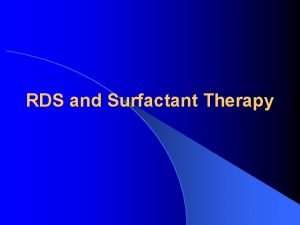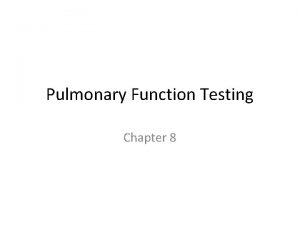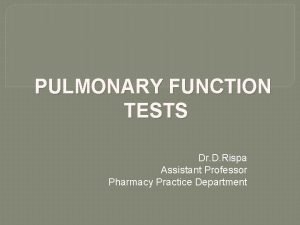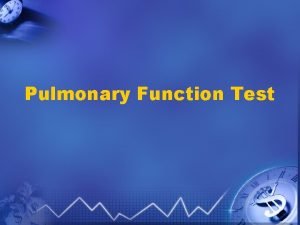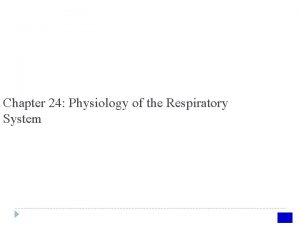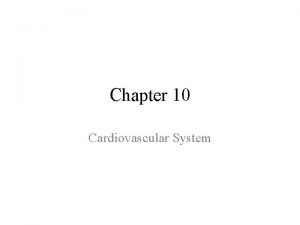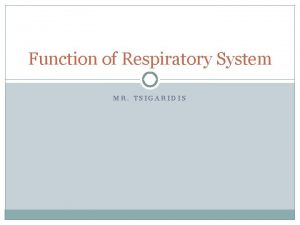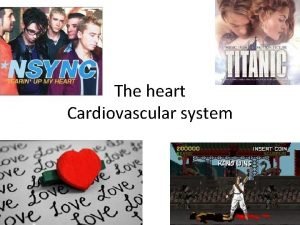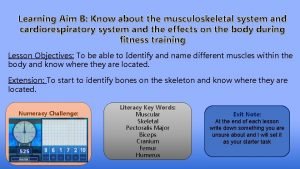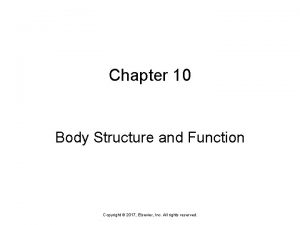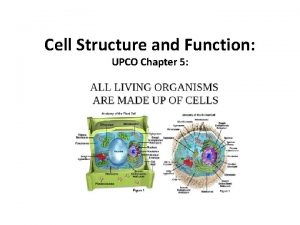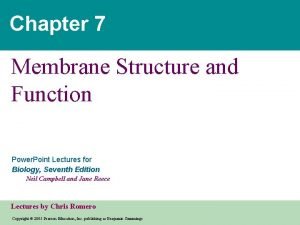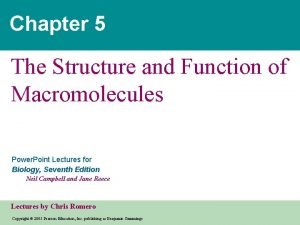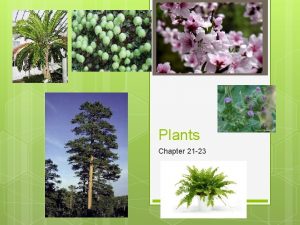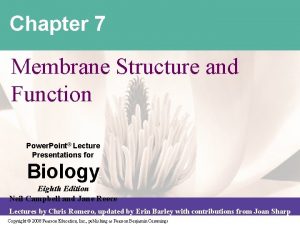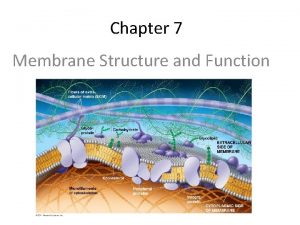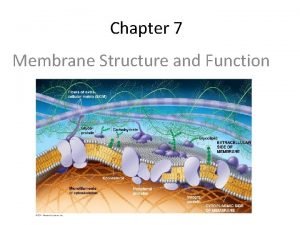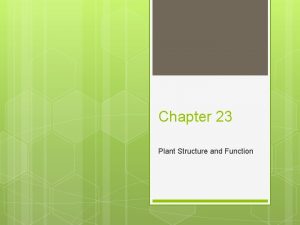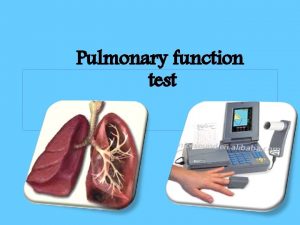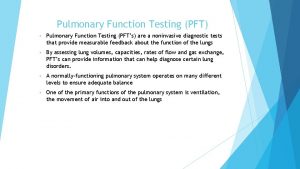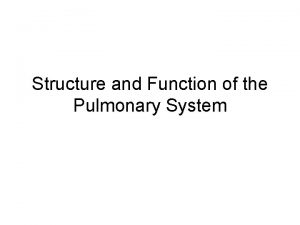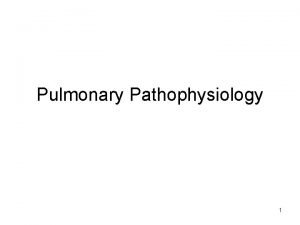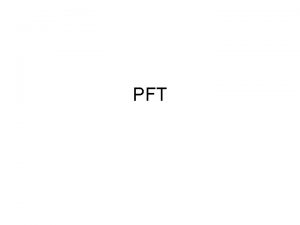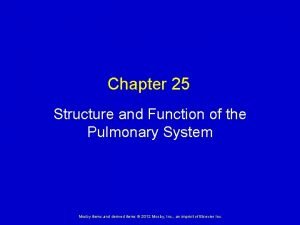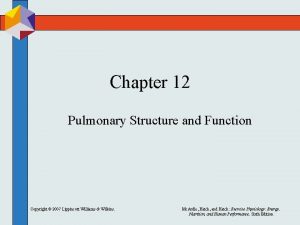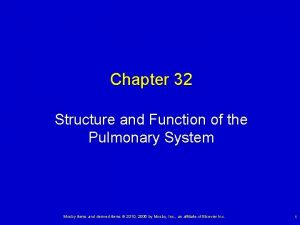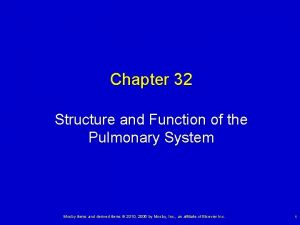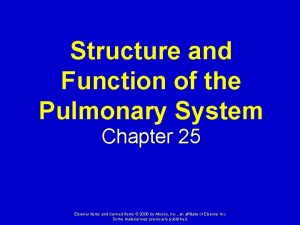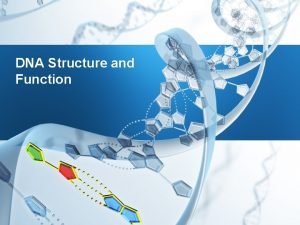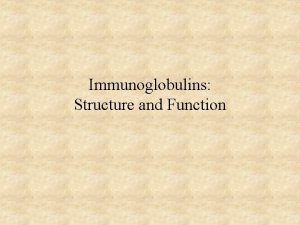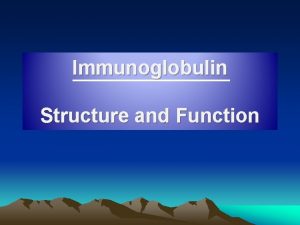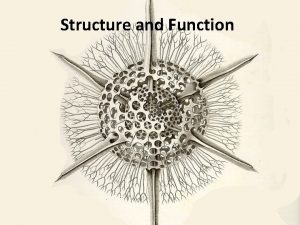Chapter 28 Structure and Function of the Pulmonary






























- Slides: 30

Chapter 28 Structure and Function of the Pulmonary System

Structures of the Pulmonary System (1 of 4) Conducting airways: Upper airways: • Nasopharynx • Oropharynx Ø Larynx • Connects upper and lower airways Ø Lower airways: • Trachea • Bronchi • Terminal bronchioles Ø

Structures of the Pulmonary System (2 of 4) From Patton KT, Thibodeau GA: Structure & function of the body, ed 15, St Louis, 2016, Mosby.

Structures of the Pulmonary System (3 of 4) Gas-exchange airways: Respiratory bronchioles Ø Alveolar ducts Ø Alveoli • Epithelial cells: Ø Type I alveolar cells (alveolar structure) Type II alveolar cells (surfactant production) • Macrophages Immune protection

Structures of the Pulmonary System (4 of 4) Redrawn from Thompson JM et al: Mosby’s clinical nursing, ed 5, St Louis, 2002, Mosby.

Question 1 1. Which of the following is TRUE regarding the pulmonary system? A. B. C. D. Each lobe is divided into bronchi. The left lobe is divided into three lobes. The mediastinum contains the lungs and heart. The larynx connects the upper and lower airways. Note: No input needed to proceed

Question 1 Answer Correct Answer: D The larynx connects the upper and lower airways. The mediastinum is located between the lungs and contains the heart, great vessels, and esophagus. The right lung has three lobes, and the left lung has two. Each lobe is divided into segments and lobules.

Pulmonary Circulation (1 of 4) Functions: Gas exchange Ø Nutrients to lung tissue Ø Reservoir for left ventricle Ø Filtering system (clots, air, and debris) Ø Lower pressure than the systemic circulation One third of pulmonary vessels are filled with blood at any given time

Pulmonary Circulation (2 of 4) Pulmonary artery divides and enters the lung at the hila Each bronchus and bronchiole has an accompanying artery or arteriole Ø Arterioles divide to form network of pulmonary capillaries around acinus

Pulmonary Circulation (3 of 4) Alveolocapillary membrane Formed by the shared alveolar and capillary walls Ø Gas exchange occurs across this membrane Ø Pulmonary veins Each drains several pulmonary capillaries Ø Dispersed randomly throughout the lung Ø Leave the lung at the hila and enter the left atrium Ø

Pulmonary Circulation (4 of 4) Adapted from Montague SE, Watson R, Herbert R: Physiology for nursing practice, ed 3, London, 2005, Elsevier.

Bronchial Circulation Part of systemic circulation Functions: Moistens inspired air Ø Nutrients to airways, large pulmonary vessels, lymph nodes, and membranes around lung Ø Does not participate in gas exchange

Control of the Pulmonary Circulation Caliber of pulmonary artery lumina decreases as smooth muscle in the arterial walls contracts Contraction (vasoconstriction) and relaxation (vasodilation) occurs in response to local humoral conditions and ANS Most important cause of pulmonary artery constriction is a low alveolar PO 2 Ø Acidemia also causes pulmonary artery constriction Ø

Chest Wall and Pleura Chest wall Skin, ribs, and intercostal muscles Ø Thoracic cavity Ø Pleura Serous membrane Ø Parietal and visceral layers Ø Pleural space (cavity) Ø Pleural fluid Ø

Thoracic Cavity From Thibodeau GA, Patton KT: Anatomy & physiology, ed 3, St Louis, 1996, Mosby.

Functions of the Pulmonary System Ventilate the alveoli Diffuse gases into and out of the blood Perfuse the lungs so the body receives oxygen

Ventilation (1 of 3) Mechanical movement of gas or air into and out of the lungs Minute volume Ø Ventilatory rate multiplied by the volume of air per breath Alveolar ventilation

Ventilation (2 of 3) Neurochemical control Respiratory center • Dorsal and ventral respiratory groups • Pneumotaxic and apneustic centers Ø Lung receptors: • Irritant receptors • Stretch receptors • J receptors Ø Chemoreceptors: • Central chemoreceptors • Peripheral chemoreceptors Ø

Ventilation (3 of 3)

Muscles of Breathing (1 of 2) Major muscles of inspiration: Diaphragm Ø External intercostals Ø Accessory muscles of inspiration: Sternocleidomastoid muscle Ø Scalene muscles Ø Accessory muscles of expiration: No major muscles of expiration; normally passive Ø Abdominal muscles Ø Internal intercostal muscles Ø

Muscles of Breathing (2 of 2) Modified from Thompson JM et al: Mosby’s clinical nursing, ed 5, St Louis, 2002, Mosby.

Mechanics of Breathing (1 of 2) Alveolar surface tension and ventilation Ø Function of surfactant Elastic properties of the lung and chest wall: Elastic recoil Ø Compliance Ø Airway resistance Work of breathing

Mechanics of Breathing (2 of 2)

Gas Transport (1 of 6) Four steps Ventilation of the lungs Ø Diffusion of oxygen from the alveoli into the capillary blood Ø Perfusion of systemic capillaries with oxygenated blood Ø Diffusion of oxygen from systemic capillaries into the cells Ø Diffusion of CO 2 occurs in reverse order

Gas Transport (2 of 6) Alveolar oxygen tension (PAO 2) Amount of oxygen available for diffusion from alveoli into blood Ø Measured by: • Barometric pressure • Water vapor • Fraction of inspired oxygen (FIO 2) • Adequacy of ventilation Ø

Gas Transport (3 of 6) Distribution of ventilation and perfusion Gravity and alveolar pressure Ø Lungs divided into zones based on factors affecting pulmonary blood flow Ø Ventilation-perfusion ratio • Normal is 0. 8 Ø

Gas Transport (4 of 6) Oxygen transport Diffusion across the alveolocapillary membrane Ø Determinants of arterial oxygenation: • Hemoglobin binding • Oxygen saturation Ø Oxyhemoglobin association and dissociation • Oxyhemoglobin dissociation curve • Bohr effect Ø

Gas Transport (5 of 6) From Lane EE, Walker JF: Clinical arterial blood gas analysis, St Louis, 1987, Mosby.

Gas Transport (6 of 6) Carbon dioxide transport Dissolved in plasma Ø Bicarbonate Ø Carbamino compounds Ø Haldane effect

Aging and the Pulmonary System Decreased chest wall compliance and elastic recoil of the lungs Ø Reduces ventilatory reserve Decreased surface area for gas exchange as well as capillary perfusion decreasing exercise capacity
 Pulmonary surfactant function
Pulmonary surfactant function Pulmonary loop
Pulmonary loop Pulmonary function test slideshare
Pulmonary function test slideshare Fev 1
Fev 1 What is the physiology of respiration
What is the physiology of respiration Pulmonary artery and aorta
Pulmonary artery and aorta Bronchi diagram
Bronchi diagram Pulmonary ventilation consists of two cyclic phases,
Pulmonary ventilation consists of two cyclic phases, Aorta inferior vena cava
Aorta inferior vena cava Aorta and pulmonary artery
Aorta and pulmonary artery Structure of the heart
Structure of the heart The circulatory system
The circulatory system Pulmonary volumes and capacities
Pulmonary volumes and capacities Chapter 10 body structure and function
Chapter 10 body structure and function Biology chapter 7 cell structure and function
Biology chapter 7 cell structure and function Chapter 22 plant structure and function answer key
Chapter 22 plant structure and function answer key Chapter 7 cell structure and function section review 7-2
Chapter 7 cell structure and function section review 7-2 Chapter 5 cell structure and function
Chapter 5 cell structure and function Chapter 7 membrane structure and function
Chapter 7 membrane structure and function Chapter 5 the structure and function of macromolecules
Chapter 5 the structure and function of macromolecules Chapter 21 plant structure and function
Chapter 21 plant structure and function Chapter 7 membrane structure and function
Chapter 7 membrane structure and function Flaccid cell
Flaccid cell Chapter 7 membrane structure and function
Chapter 7 membrane structure and function Section 23-4 leaves
Section 23-4 leaves Hình ảnh bộ gõ cơ thể búng tay
Hình ảnh bộ gõ cơ thể búng tay Bổ thể
Bổ thể Tỉ lệ cơ thể trẻ em
Tỉ lệ cơ thể trẻ em Chó sói
Chó sói Glasgow thang điểm
Glasgow thang điểm
